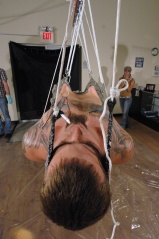 |
Peter Masters |
Peter Masters |
|
|
|||||
| About me | About this site | My books | |||||||
Suspension
| Bondage articles | |
| Rope bondage | Predicament bondage |
| Rope bondage (functional) | Suspension bondage |
| Rope bondage (decorative) | Mummification |
| Rope harness | Breast bondage |
| Metal bondage | Hog-tie |

Figure 1. Suspension using a rope harness attached to a tree

Figure 2. Hog-tie with suspension

Figure 3. Girl suspended using leather cuffs for her hands and rope for her ankles. Note the additional breast bondage. Also note that the wrists and shoulders are under a great deal of stress in this sort of suspension

Figure 4. Girl suspended from a spreader bar using leather cuffs and carabiners. Note that there can also be significant stress on joints in the arms and legs here, particularly the wrists and shoulders

Figure 5. Suspension using hooks through flesh
Suspension, or suspension bondage, is an activity where a submissive or bottom is tied and then suspended from an anchor point or suspension frame some distance above the ground.
The frame or anchor point must, of course, be solid and secure. Anchor points are commonly bolts firmly sunk into the ceiling when the ceiling is concrete, or into ceiling beams where the ceiling is made of wood.
Suspension frames may be made of wood or steel. Some specialised suspension frames are demountable and can easily be disassembled, packed into a car, and then reassembled at a play party or other venue.
An important element of suspension is ensuring that the submissive's arms, legs, head, and body are well-supported during the initial lift and during the suspension itself. Figure 2 shows a suspension where the arms, legs, torso, and head are all well-supported, with the head being supported via straps around the head (which, at the same time, hold a ball gag in place).
Figure 1 shows just the torso being suspended through the use of a rope harness. Note that the upper body, head, and the legs are left to dangle. This sort of position can quickly become uncomfortable.
Figure 3 shows suspension using wrist cuffs and ropes tied to the ankles. This position places stress on the hips, ankles, wrists and shoulders, and care must be taken when doing something like this to ensure joints don't dislocate. Tickling is definitely counter-indicated.
Figure 4 shows suspension using wrist and ankle cuffs attached to a suspended spreader bar. This can place stress on the wrists and shoulders as these are bearing around half the weight of the submissive. On the other hand, this position does leave the submissive's genitals quite exposed for other play.
Generally, the person being suspended will initially be tied while resting on the ground. Hand-driven or electric chain winches are perhaps the most common devices used to hoist the person into the air once the tie is complete.
For safety reasons something soft, such as pillows or mattresses, are sometimes placed under the person being suspended. This isn't just for cases where the rope or equipment breaks, but is also for when the person needs to released quickly---such as when they become distressed or when they experience a medical problem (such as light-headedness, nausea, etc.).
Fear may play a role in the effectiveness of suspension scenes, and in some cases a blindfold can be used to enhance the effect.
Suspension using hooks through flesh
Some folk practice suspension using hooks through their flesh instead of a rope harness (see figure 5). Rather than being strictly an activity with BDSM goals this sort of suspension is more often an exercise in meditation or personal endurance.
As there is a significant overlap between hook suspension and the more conventional BDSM rope suspension, it makes sense that it is frequently performed in a BDSM context---such as in a BDSM dungeon or at BDSM parties or workshops. The equipment and precautions necessary do it all safely are basically the same as for similar BDSM activities.
Books
- Screw the Roses, Send Me the Thorns: The Romance and Sexual Sorcery of Sadomasochism (Philip Miller and Molly Devon)
- Two Knotty Boys Showing You The Ropes: A Step-by-Step, Illustrated Guide for Tying Sensual and Decorative Rope Bondage (Two Knotty Boys)
- Shibari You Can Use: Japanese Rope Bondage and Erotic Macramé (Lee "Bridgett" Harrington)
- The Seductive Art of Japanese Bondage (Midori)
See also
- Fakir at Wikipedia
- Suspension at Wikipedia